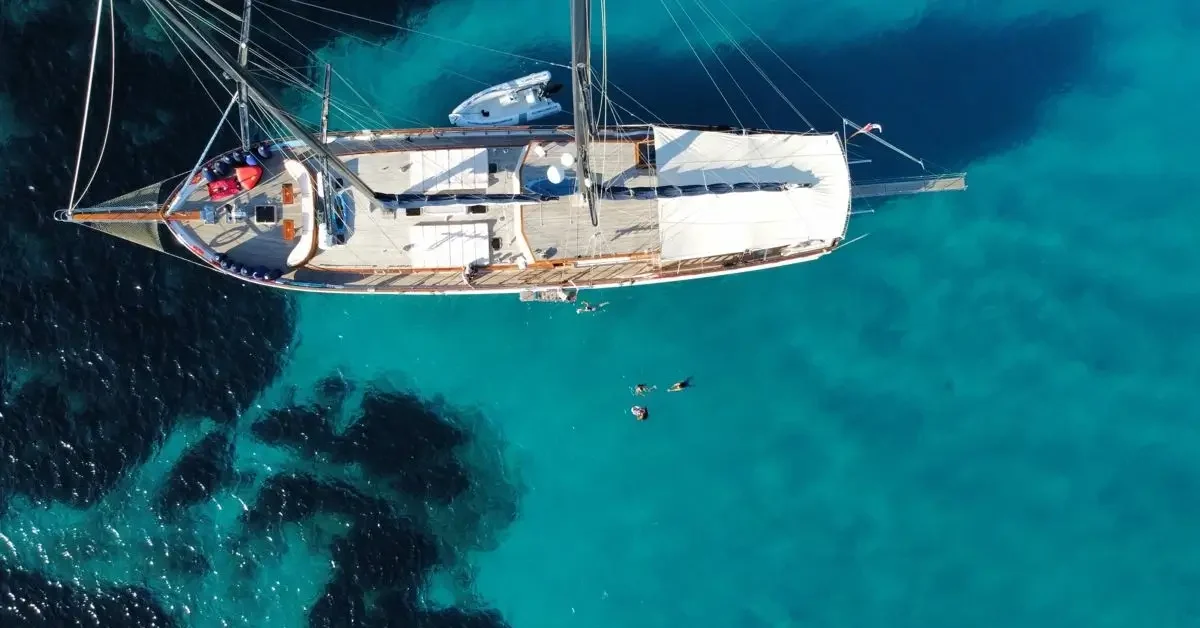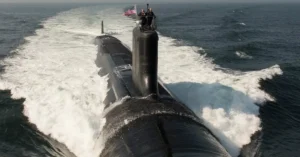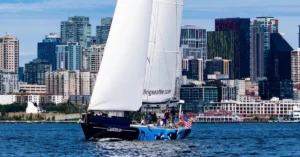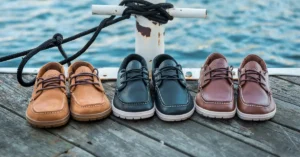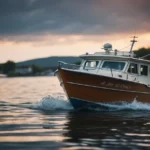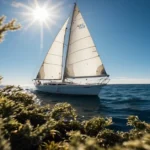When we think of sailboats, it’s easy to picture just one type. However, the world of sailing boasts a plethora of sailboat types, each with unique characteristics and suited for different sailing adventures. Understanding these types of sailboats enriches our appreciation for this time-honored pursuit and helps us choose the suitable vessel for our needs.
Our article will explore the various types of sailboats to help you recognize and appreciate the diverse range of sailing vessels. From the simple single-mast designs to the more complex multi-masted and multi-hull boats, our goal is to understand the different sailing options clearly. So, let’s set sail and discover the fascinating realm of sailboat types!
Understanding Sailboat Anatomy
When exploring the types of sailboats, it’s essential to understand their anatomy, as different components and configurations affect their performance and characteristics. This section will cover Rig and Mast Fundamentals, The Hull and Keel, Essential Sailboat Equipment, and Other Important Components to provide a solid foundation for understanding sailboats.
Rig and Mast Fundamentals
Sailboats come in various rig systems, including the Bermuda rig, Gaff rig, and several mast configurations like sloop, ketch, yawl, and schooner. The rig refers to the arrangement of spars, masts, and sails essential for propulsion. The mast is a central, vertical pole that supports the sail, while spars are the horizontal supports.
Some standard mast configurations are:
- Single Mast: Typically seen in sloops
- Two Masts: Common in ketches and yawls
- Three or more Masts: Found in schooners and tall ships
The Hull and Keel
The hull forms the main body of a sailboat and can be made of various materials such as fiberglass, wood, or metal. Hulls also come in different types, such as:
- Monohull: Standard single-hulled design
- Multihull: Catamarans and trimarans with two or three hulls
The keel is critical in stabilizing the sailboat and counteracting the pressure from the wind on the sails. Some common keel types include:
- Fin Keel: A long, narrow keel with a low aspect ratio
- Wing Keel: A modified fin keel with wing-like appendages for better stability and shallow draft
- Full Keel: A wide, shallow keel that runs the length of the hull
Essential Sailboat Equipment
Sails are the primary means of propulsion for a sailboat. The mainsail is the giant sail, and its size and shape depend on the rig type. Other sails, such as headsails (including foresails and staysails), are attached to the front of the mast.
A sailboat’s steering system typically includes:
- A rudder.
- A vertical blade is attached to the stern.
- A tiller or wheel to control its movement.
Other Important Components
In addition to the main structural elements, several other vital components ensure a comfortable and safe sailing experience. These include the heads (toilets), berths (sleeping spaces), and galley (kitchen).
By understanding the anatomy and components of a sailboat, we can better appreciate its intricate design and engineering, ultimately enhancing our sailing experience and knowledge of different types of sailboats.
Exploring different Types of Sailboats

When it comes to types of sailboats, there’s a wide variety to choose from. In this section we will explore the different kinds of sailboats, starting with the fundamental distinction between monohulls and multihulls and then diving into specific sailboat styles.
Monohulls vs Multihulls
There are two main categories of sailboats based on their hulls: Monohulls and Multihulls. As the name suggests, monohull sailboats have a single hull, while multihull sailboats have more than one hull connected by a frame or platform. Examples of multihulls include catamarans, which have two hulls, and trimarans, which have three hulls.
Monohulls are generally more traditional and offer a smoother and more stable ride in heavy seas. On the other hand, multihulls such as catamarans and trimarans provide more excellent stability, especially in lighter wind conditions, and have more room for passengers and gear.
Specific Sailboat Styles
Numerous specific sailboat styles fall under the monohull and multihull categories. Here are a few popular sailboat styles, along with their distinguishing features:
- Dinghy – A small, lightweight sailboat. They are often used for training or racing.
- Sloop – A single-masted sailboat with a mainsail and a headsail. This is the most common sailboat rig type.
- Cutter – Similar to a sloop, but with two headsails for better performance in strong winds.
- Ketch – A two-masted sailboat with the main mast being taller than the mizzen mast and carrying a mainsail.
- Yawl – Another two-masted sailboat with a mizzen mast shorter than the main mast and positioned aft of the rudder post.
- Schooner – A sailboat with multiple masts, where the aft mast is taller than the forward mast.
- Catboat – A single-masted sailboat with a cat rig (single sail on a mast without a headsail), often gaff-rigged.
- Motorsailer – A sailboat designed to be propelled by both sail and engine power.
- Daysailer – A small sailboat used for recreational sailing, typically without sleeping accommodations.
Each sailboat style has strengths, weaknesses, and intended uses, from casual cruising to competitive racing. By understanding the characteristics of these various sailboats, sailors can better identify the type of vessel that suits their needs and preferences.
Performance and Comfort Aspects

When discussing types of sailboats, it’s essential to consider the varying performance and comfort aspects that play a significant role in choosing the right boat for one’s needs. This section will explore two key factors: speed, stability, comfort, and other considerations.
Speed and Stability
Multihull sailboats, such as catamarans and trimarans, are known for their speed and stability. These boats have multiple hulls, which provide increased buoyancy and shallower drafts. This design contributes to faster speeds, reducing wet surface area and water resistance. For example, racing sailboats often feature hydrofoils, allowing them to lift out of the water partially, further reducing drag and enhancing speed.
On the other hand, monohull sailboats, like cruising boats and daysailers, rely on their ballast and hull shape for stability. Various keel designs, such as daggerboard, centerboard, and bilge keel, can impact a boat’s stability. A sailboat with a daggerboard keel or centerboard may offer improved performance by reducing draft and resistance while providing lateral resistance.
Comfort and Other Considerations
In contrast, boats designed for leisure and comfort, like cruising sailboats or pocket cruisers, may prioritize space and amenities over speed. Displacement can significantly affect a boat’s comfort while sailing in various sea conditions. For example, a heavier displacement contributes to a more comfortable motion in rough seas (Yachting Monthly).
Materials used in sailboat construction may also impact their performance and comfort. Common materials include wood, fiberglass, and aluminum. Wood can be beautiful but requires extensive maintenance, while fiberglass is famous for its durability and low maintenance.
To summarize the key points:
- Speed: Multihulls like catamarans and trimarans are generally faster due to their reduced wetted surface area and hydrofoil options.
- Stability: Monohulls rely on ballast and keel design for stability, with variations such as daggerboard, centerboard, and bilge keel.
- Comfort: Heavier displacement boats may offer a smoother ride in rough seas, while material choices, such as wood or fiberglass, can impact maintenance and durability.
Our Top Five Types of Sailboats

As avid sailboat enthusiasts, we’ve experienced the joy and freedom that different Types of sailboats can offer. This article will introduce you to our top five favorites that always delight.
Catamarans capture our hearts with spacious layouts, water stability, and leisurely cruising potential. Gliding effortlessly across the ocean on twin hulls is a thrill.
Sloops exemplify classic elegance through their single mast configuration, making them an accessible choice for beginners and experts alike.
Ketches charm us with their versatile two-mast setup. Their enhanced sail control and nostalgic design perfectly balance functionality and nostalgia.
Yawls stir our romantic sides with their additional mizzen mast, connecting us to sailing’s rich heritage.
For those seeking speed and agility, Trimarans always amaze us with their cutting-edge triple hulls. These boundary-pushing vessels are a force to be reckoned with in any regatta.
After years of sailing adventures together, these five types continue to leave their mark on our hearts. Each offers unique qualities that feed our passion for the open water. Whether you favor tradition or pushing limits, considering these top picks is a great start to finding your perfect match on the waves.
FAQ – Types of Sail Boats

The variety of sailboats can be overwhelming when it comes to sailing. To help you find the perfect sailboat to suit your needs, we’ll discuss some critical factors to consider and provide a brief guide to the types of sailboats available in our FAQ Section
What are some factors to consider when choosing a sailboat?
Some critical factors to consider include size, layout, type of hull, and the sail plan. You’ll also want to remember your intended use (racing, cruising, or just leisurely weekend sailing) and the size of your crew or family.
What are some popular types of sailboats?
Monohulls: The traditional single-hulled boat, often with a fixed keel.
Catamarans: Twin-hulled boats known for their stability and speed.
Trimarans: Triple-hulled boats offer even more stability and performance.
What are some features to look for in a sailboat’s layout?
Depending on your needs, you might consider the following features:
Berth: Sleeping accommodations for crew and guests.
Gallery: The onboard kitchen.
Head: The bathroom facilities.
Sailing: The ease of handling the boat, especially for single-handed sailors. Some sailboats, like the Optimist or Solo, are explicitly designed for this purpose.
How do wind conditions affect the choice of a sailboat?
Your local wind conditions may dictate the type of sailboat best suited for your location. Light wind areas may require a boat with a larger sail plan, while heavy wind areas may call for a ship equipped with reefing systems to handle stronger gusts.
Are there any standout sailboat brands?
Many reputable sailboat brands range from smaller boats like Optimist and Solo to luxury yachts such as Beneteau, Jeanneau, and Hanse. Your choice will ultimately depend on budget, personal preferences, and intended use.
We hope this information helps you decide on the types of sailboats that best suit your needs. By considering factors such as size, layout, and intended use, you can find the perfect sailboat that will provide you with years of enjoyable sailing experiences.
We’ve covered many Types of Sailboats- now it’s your turn. Tell us about Your favorite Sailboat and share experiences, tips, or stories in the comments below.

